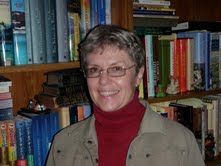Welcome, everyone! Have you ever wished you could sit in on one of Sue Harrison’s writers workshops? Now you can, a few minutes at a time. Over the next many months you are invited here for a writers workshop, the fourth Thursday of each month, for Sue Harrison‘s teaching about Writing The Third Dimension. Sue invites you to ask questions and leave comments, to which she will gladly respond. If you miss one segment, you can still have access to them all. Just mouse over Writers’ Helps & Workshops on my drop down menu, then click on Writing The Third Dimension.
When I asked her what it means to write the third dimension, Sue explained, “Basically, the concept is for writers to write their characters, scenes, and plots in such a way that they “pop” off the two-dimensional page and assume a three-dimensional presence in the reader’s mind – as if the reader had actually lived the story.” Now we are going to learn how to do that. 🙂
“Writing the Third Dimension” – part 1: Heart Breaker
I love the story about the elderly Athabascan woman who was asked how to make moosehide moccasins. Her reply? “Well, first you kill a moose.”
In other words, have a seat. This is going to take a while.
When I’m asked, “How do you write a novel?” My answer is, “Well, first you break a heart.”
And not just any old heart, but the heart of the main character. When an author writes a novel, his/her goal is to tell a story so compelling that the reader doesn’t want to put it down. That means the novelist must establish a strong connection between the reader and the book’s main character. The only sure way to do that is through emotions.
I might not know what it’s like to live thousands of years ago in the Aleutian Islands, but I can relate to an Aleut woman who loses the man she loves in a vicious raid. I feel the emotional connection, and I want to read her story, live her life, and discover how she finds love again. Because she and I are sisters. We both know what it is to have a broken heart. (Okay, I admit it. I’m advertising one of my own novels, Mother Earth Father Sky.)
So, if you’re a writer, how do you go about breaking that main character’s heart? You do it by knowing your main character so well that you understand what is at the center of her soul. Ask yourself these questions: What is most important thing/person/belief in her life? What is the foundation of her self-esteem? What does she love most? Once you know that, then you’ve solved your problem, and what you must do is take that most precious thing away from her. Then she’s in the fight of her life as she tries to survive and win back what she’s lost. Suddenly you have a plot; you have a story. You’ve pushed your character off the two-dimensional page and made her come alive in your reader’s mind.
Tell me about your main character. What is at the center of his or her self-esteem? What does he love the most? What will break her heart?
Blessings, Sue *Writing the Third Dimension, copyright, 2010 Sue Harrison*
 Bestselling author, Sue Harrison, has written two Alaska trilogies: The Ivory Carver Trilogy and The Storyteller Trilogy, and a middle readers’ book SISU. Prior to the publication of her novels, Harrison was employed at Lake Superior State University as a writer and acting director of the Public Relations Department and as an adjunct instructor in creative writing and advanced creative writing. For more information, click here. To inquire about booking Sue for workshops or speaking engagements this year, click here.
Bestselling author, Sue Harrison, has written two Alaska trilogies: The Ivory Carver Trilogy and The Storyteller Trilogy, and a middle readers’ book SISU. Prior to the publication of her novels, Harrison was employed at Lake Superior State University as a writer and acting director of the Public Relations Department and as an adjunct instructor in creative writing and advanced creative writing. For more information, click here. To inquire about booking Sue for workshops or speaking engagements this year, click here.
Thanks for joining us! Please feel free to leave your questions and comments. Next installment February 28, 2013.



Excited for next installment,Sue!! 2/28/13!!
LikeLike
Thank you, Mary!!
LikeLike
I look forward to your continuing installments on this topic. How would you say “writing the third dimension” differs from the concept of deep point of view, or are they the same thing?
LikeLike
Thank you for your question, Carol. It’s a great one!!
Deep point of view generally refers to using characterization techniques (with special emphasis on thought processes and sensory perception) in such a way that the reader becomes the character. It’s hard to master, and I’ll be the first to say that I count myself a novice in that ability. I’m still learning, still striving.
The problem with many attempts at deep point of view is that a writer (okay, I’m talking about myself here) tends to get flowery and over-write, which pops the reader out of the character even more quickly than just simply telling the story. I’m a fan of deep point of view, but in striving to learn the technique, I’ve become very aware of how many ways I can fail.
Back to your question, Carol! “Writing the third dimension” includes deep point of view. It also includes word choice, sentence structure, plot lines, research information, and the author’s relationship with his/her characters. A lot of that is “silent.” It’s like the behind the scenes guy who closes the curtains, the gal in the orchestra pit who plays the flute, the costume-designer, the make-up artist. The behind-the-scenes commotion that provides the dimensional shading in a novel functions just like the cross-thatching an artist adds to make his sketch pop off the paper and find reality in the eyes of the beholder.
LikeLike
I needed to hear this. Lately I have been wandering around my novel like a tourist. There are so many roads to take, too many. My “plot” had not been clear enough.
LikeLike
Patricia, I hope you’ll join us here each month with Writing the Third Dimension. If you have specific questions about your plot, please feel free to ask them here, or email me at sue@sueharrison.com. I’m in your corner.
LikeLike
Sue, I like how you’ve expanded/qualified the ‘broken heart’ so that you get beyond romance. A pet who is lost can break a child’s heart, or a parent/child relationship that goes off the rails can be devastating. Or losing a parent to dementia. But yes, something that is heartbreaking gives the story a defining moment and momentum. Thanks for expressing it this way, it really helps my thinking and plotting process.
(Trish Webb, is that you? Fancy finding you here, tee hee hee)
LikeLike
Thank you for your comments, Janie. I might mention here that if anyone is interested in following a “new” writer as she goes through the process of having her first novel published, you’ll want to catch up with Janie Chang on her website/blog!
LikeLike
Looking forward to the next installment. You are right when a reader picks up a book & connects with the main character she is hooked!!
LikeLike
That sure happens for me, Trish. I love it when, within a page or two, I’m hooked and don’t want to put the book down.
LikeLike
Great information Sue. I look forward to hearing more.
LikeLike
Thank you, Darlene. We’re going to have a lot of fun here!
LikeLike
So helpful! I like it! Angela: 1) family/being a normal person 2) still thinking… 3) being the most normal person in her family – or so she thought… 😀
LikeLike
Glad you like it, Erik! Thank you!
LikeLike
Angela sounds like a very interesting person, Erik. Hmmmm. Normal or so she thought…. I’m hooked!
LikeLike